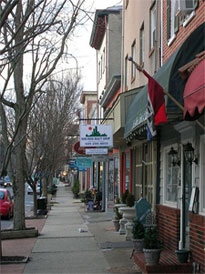Historic Town Chooses to “Retain Its Charm” By Enabling Sprawl
 On Friday, Streetsblog looked at how northern Virginia can’t get enough road widening. As a follow-up, Gary Toth of Project for Public Spaces directed us to another example of how smart growth faces hurdles in the places that need it most — in this case, the Trenton suburb of Bordentown, New Jersey (right: the main drag).
On Friday, Streetsblog looked at how northern Virginia can’t get enough road widening. As a follow-up, Gary Toth of Project for Public Spaces directed us to another example of how smart growth faces hurdles in the places that need it most — in this case, the Trenton suburb of Bordentown, New Jersey (right: the main drag).
Residents in the village of 4,000 recently voiced their opposition to a proposal that would encourage mixed-use and infill development, reports the Burlington County Times:
The ordinance would allow for the addition of up
to 100 dwellings downtown. It would allow developers to put apartments
or condominiums above storefronts and would increase the allowable
height for buildings. Currently, developers have to obtain variances to
do such things.
The rejection of the zoning changes was stoked by fears that the town’s historic character would be threatened, among other things:
Some argued that the ordinance would create more
traffic, noise and parking problems. If the town’s population increased
as a result of the ordinance, demands on municipal services and schools
would also increase, possibly resulting in higher taxes for property
owners, they said.
But as Toth points out, pushing development outside the town center will create more traffic, not less. "Ironically, people oppose [the re-zoning] based
on the incorrect assumption that it will add traffic," he said. "Yet what
will take the place of the infill will be sprawl development which will
choke off their quaint little town and make things far worse."
"NJ Transit invested billions to build the Trenton-to-Camden light rail line to help shape New Jersey’s future towards a more walkable, less car-dependent region" he added. But even though Bordentown is located on a transit corridor, it won’t see
"transit-oriented development" until residents buy into the notion that clustering growth downtown is in their best interest. As the Trenton Times reports, the uproar over the ordinance has led commissioners to scuttle the promotion of development near the center of Bordentown and its rail station:
They deleted provisions for apartments, 100 additional
housing units in a proposed town center zone, residential
flats above commercial structures downtown, four-story
buildings in the town center and bed and breakfasts.And they removed all mention of the term "transit
village" from the document.
Disinformation about smart growth-style development — like the assumption that it will lead to densities resembling Manhattan’s — is rampant even along transit corridors, Toth said. Countering those perceptions, he believes, requires a targeted PR effort promoting more compact development as an avenue toward relieving traffic congestion.
Photo: steve367 / Flickr